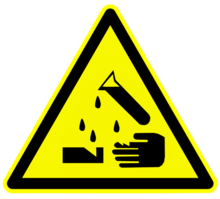
Recent chemical spills encourage review of laboratory practices.
On two different occasions, 2.5-liters were dropped and the glass bottle broke to release its contents. Glacial acetic acid and concentrated sulfuric acid were the hazardous materials involved in the incidents.
LEADERSHIP:
- Share this information with your lab personnel, be they Faculty, Staff or Students
- Ensure personnel have lab-specific safety training before working in the lab
- Create opportunities for continuous learning relating lab safety
- Use personal protective equipment including lab coats
- Create regular opportunities to discuss safety. Focus on solving problems rather than assigning blame
- Participate in and encourage open, ongoing dialog about safety
- Conduct hazard analysis prior to any experimental procedures
Guidelines for spill response planning:
- Spills in the laboratory can be prevented with good laboratory practices
- Know your limits. If you do not have the basic knowledge to confidently make the decisions required or if you have not been trained, request assistance from others
- Be prepared
- Learn about the hazards of the chemicals in your laboratory – Review safety data sheets
- Write Standard Operating Procedures (SOPs) to address hazards
- Have equipment and training necessary to follow the above SOP’s
- Prepare for spills with advance planning using the following spill prevention techniques:
|
Potential Cause of Spill |
Prevention Technique |
|
Container, such as a flask or beaker, tips over |
Secure containers and equipment to minimize the possible of tipping. |
|
Container dropping |
Keep containers and experimental equipment as low as possible. |
|
Breaking a container or a piece of experimental apparatus |
Protect containers from breakage by keeping other items from falling on them. |
|
A runaway reaction |
Plan experimental reactions to anticipate and to provide controls for undesired outcomes such as overheating. |
|
Releases during transfer of materials from one container to another |
Pay attention to what you are doing. Provide secondary containment in the event of spills. |
|
Holes and other leaks in transfer equipment such as pipes, hose, or valves |
Check for holes or leaks before use. |
|
Placing material in an incompatible container |
Check for compatible uses of chemicals, particularly solvents or aggressive solutions. Check the material and construction of containers and equipment with a goal of maintaining structural integrity. |
|
Breakage of thermometers or similar experimental equipment |
Select equipment that has reduced potential for breakage, e.g., replace mercury thermometers and electronic temperature devices. |
|
Breakage of container when dropped |
Purchase products in Safe-Cote™ or plastic-coated bottles so if they break, glass fragments and liquids are more likely to remain trapped. |
Please review the attached chemical spill prevention file (PDF) >>
We encourage you to share the information with your colleagues. Use as many prevention measures as possible to keep our people, environment, and communities safe.
Stay Safe Out There!
Department of Environmental Health & Safety
ehs@wright.edu

